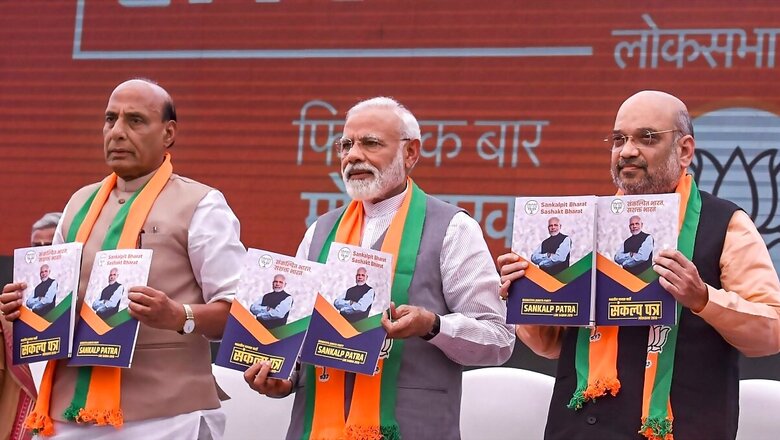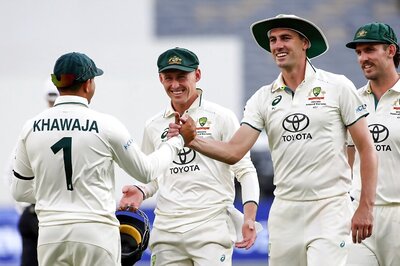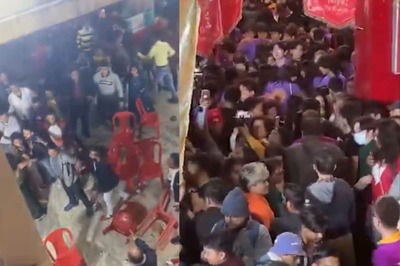
views
The 2024 Lok Sabha elections have entered midway with the completion of four phases and only three phases remaining. During this election, the centre of discussion has been the low voter turnout — although in the fourth phase, this trend reversed with a marginal increase in turnout percentage compared to 2019.
Amid this, the Opposition leaders have started claiming that the BJP’s numbers are falling. Congress leader Rahul Gandhi said the BJP would win 180 seats, but days later he revised the figures to 150. Compared to Rahul, who seems to be very strict regarding the BJP’s figures, TMC supremo and West Bengal Chief Minister Mamata Banerjee gave more seats to the BJP — 195, at best. However, AAP supremo and Delhi Chief Minister Arvind Kejriwal seems to be more liberal than Gandhi and Banerjee when it comes to assigning numbers to the BJP. He projected that the saffron party may get 220 seats.
When the Opposition leaders are trying their best to propagate that the BJP is even struggling to cross the 200 mark, this month, in an election rally in Krishnanagar, West Bengal, Prime Minister Narendra Modi claimed that people have decided that the BJP-led NDA is poised to secure not only 370 seats but is looking forward to crossing the 400 mark. Such claims are routine for politicians during the election season to energise their ground-level workers and attract floating voters.
But what caught the attention are the claims made by some journalists and political analysts, who are saying that the BJP is unlikely to get a majority on its own — and even the NDA may struggle to get the majority on its own. Psephologist turned political leader and activist Yogendra Yadav has given a loose figure of around 233 seats based on his “ground assessment” to the BJP and around 268 seats to the NDA.
A revisit to the 2019 election
Before analysing the current election, first let’s revisit the 2019 Lok Sabha election, which is being cited nowadays often by many journalists and political commentators. According to this section, this year’s election has no dominant narrative unlike the 2019 election, which, according to them, was won by the BJP-led NDA with a big mandate because of the nationalist wave generated by the Pulwama terror attack followed by the Balakot airstrike. Interestingly, a section during the election campaign then had claimed 2019 as “a waveless election”. Nevertheless, post the results, they concluded that Modi came to power for the second time only because of the opportunity provided by the Pulwama terror attack.
This argument is faulty, that’s why a revisit to the 2019 elections is necessary. According to the Lokniti-CSDS post-poll study, the Pulwama terror attack and Balakot air strike were important issues for only 0.4 per cent of voters while voting. The survey pointed out that development was an important issue for 14.3 per cent of voters. This was followed by unemployment, which was important for 11.3 per cent of voters. Other issues included economic growth, corruption, price rise, water-related problems etc. These figures have been in the public domain for the last five years, still, it is amazing that in this country, we have some eminent journalists and political commentators misinterpreting the 2019 election as mostly decided on the basis of Pulwama and Balakot.
Despite Dissatisfaction, Modi Remains Popular
Coming to the 2024 elections, Lokniti-CSDS released a pre-poll survey in April where the data pointed out that the satisfaction level towards the Modi government has seen a dip of around 8.1 per cent — a sign of serious concern for the BJP. Increasing unemployment (12.2 per cent), price rise (7.6 per cent) and falling income (4.1 per cent) are some of the crucial issues in the survey that matter to voters. The pre-poll survey also points out that there is an increase of around 5 per cent in support for Congress leader Rahul Gandhi — 26.5 per cent — as the next prime minister compared to the 2019 pre-poll survey. Interestingly, there is also a 2 per cent increase in support for Narendra Modi — 47.5 per cent — as the next prime minister. This is despite 10 years of anti-incumbency.
Why Narendra Modi Remains Popular
Many journalists and political commentators are seen discussing that Ram Mandir in Ayodhya isn’t a poll issue. First of all, this isn’t an issue for a particular election — Ram Mandir is a sentiment for the Hindus. That said, it’s still an issue in this election. According to the pre-poll survey, for 7.5 per cent of voters, Ram Mandir is an important issue when they vote, with an additional 2.3 per cent of voters separately pointing to Hindutva as an important issue when they vote. Clearly, the BJP’s Hindutva agenda remains a significant factor for 9.8 per cent of voters in this election, though a small fraction of them may be anti-Hindutva voters.
Unemployment remains the most important issue for voters — 27.3 per cent — when they vote. However, it is wrong to conclude that all voters citing unemployment as an important issue are necessarily anti-BJP voters. If they vote for the Modi-led BJP, liberals and Leftists label them as being “blind” towards basic issues like unemployment and price rise. Interestingly, according to the pre-poll survey, 9.1 per cent of voters cited employment as the most liked work of the Modi government — the second most liked factor after Ram Mandir. This means that there is a section that believes that although unemployment is a burning issue, the Modi government has been working to address it.
After unemployment, price rise has been cited by 23.4 per cent of voters as an important factor. However, it’s worth noting that despite price rise being an important issue during the 2009 elections, the Congress-led UPA came to power with an increased number of seats. This is not to deny the disillusionment of voters towards the Modi government on price rise. However, welfare schemes, cited by 18.1 per cent of voters as the biggest change since Modi became prime minister, and infrastructure-related works are likely to aid the government, lessening the impact of this disillusionment and preventing it from converting into votes against the BJP-led NDA.
Modi is aware of the ground reality
Liberals and Leftists aren’t happy with Narendra Modi’s election speeches targeting Congress-led Opposition for Muslim appeasement. They argue that this is not a significant issue. While the Congress manifesto does not discuss wealth redistribution, the CSDS-Lokniti pre-poll survey suggests that concerns about policies targeting Muslim communities resonate with some voters. The survey found that 47.3 per cent of voters agreed that Muslims are unnecessarily pampered, compared to 32.2 per cent who disagreed, while 20.4 per cent chose not to respond. Modi’s speeches on Muslim appeasement, targeting the Opposition, particularly Congress, aim to address the concerns of these voters, close to 50 per cent of those surveyed, while also appealing to undecided voters.
NDA ahead of Opposition?
In the most crucial state of Uttar Pradesh, BJP-led NDA is ahead of the Opposition, which is divided between the Samajwadi Party-Congress alliance and the BSP. Mayawati’s party may be weak but still is a force having the potential to split anti-BJP votes. Not only this, SP’s experiment to forge a social alliance with smaller caste-based parties — with some success in 2022 state Assembly polls — got setbacks with the desertion of four of the five OBC-based parties – Om Prakash Rajbhar-led Suheldev Bharatiya Samaj Party, Jayant Singh-led Rashtriya Lok Dal, Apna Dal (Kamerawadi) and Jan Janwadi Party. Two of them — SBSP and RLD — have joined the NDA. Last time, the NDA won 64 out of 80 seats, this time it is expecting gains here.
In Bihar, where the NDA almost swept by winning 39 of 40 seats, the Janata Dal (United) indeed remains a weak link for the NDA due to the decline in popularity of Bihar Chief Minister Nitish Kumar but voters too are aware that this election is not about Nitish, it’s about Modi.
There may be a loss of some seats here and there in states like Rajasthan, Maharashtra, Madhya Pradesh, Karnataka, Haryana and West Bengal but BJP and NDA may also see some gains in Uttar Pradesh, Odisha, Andhra Pradesh, Northeast, Telangana and probably in Tamil Nadu too. If this happens, BJP’s tally may get reduced but is unlikely to fall below the 272 mark with NDA likely to cross the 300 mark. This time, Chandrababu Naidu’s Telugu Desam Party is likely to add a considerable number of seats to the NDA’s tally.
Speaking arithmetically, the BJP IN 2019 won 224 seats with more than 50 per cent votes. Swing does happen but for that, the Opposition needs to be strong on the ground. Talking about the Congress, which is mostly contesting against the BJP in the Hindi belt barring Uttar Pradesh, it lacks a strong active organisation. Only creating a mahaul (environment) during the election season through social media is unlikely to help in getting votes. Opposition is already lacking behind the BJP-led NDA, which has been active on the ground much before the beginning of the election season. Kejriwal’s recent statement that BJP may get 220 seats — this number still is likely to make BJP the single largest party — gives a perception that even the Opposition isn’t very sure of their claims about the saffron party losing the elections. This gives an impression that the BJP is likely to win and it is this perception that is likely to play a role in adding the floating voters to the BJP’s side.
As the election season is progressing, the Opposition has been able to lessen this perception to some extent but will this be able to convert into votes against the BJP, and if yes, then to what extent? Will it match the threshold required to defeat the juggernaut BJP? This remains a critical question. Definitely, there is a consolidated anti-Modi wave than there was in the 2019 elections, but there is also a silent pro-Modi wave, without losing much of its 2019 strength on the ground.
Sagarneel Sinha is a political commentator and tweets @SagarneelSinha. Views expressed in the above piece are personal and solely those of the author. They do not necessarily reflect News18’s views.



















Comments
0 comment